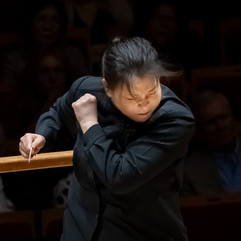Shiyeon Sung Leads Pacific Symphony in Impressive Performance of Tchaikovsky
- Timothy Mangan

- Apr 26, 2024
- 4 min read
REVIEW: The Korean conductor, the first woman to try out for the orchestra’s music directorship, exhibits authority and intelligence.

Shiyeon Sung became the first woman conductor this season to try out for the Pacific Symphony’s soon-to-be-vacant music directorship, Thursday night in the Renée and Henry Segerstrom Concert Hall, and she made a good case for herself.
The South Korean musician, 49, currently living in Berlin, is a much-traveled guest conductor with major orchestras' international stages, a former winner of two prestigious conducting competitions (and, like current music director Carl St.Clair, a former assistant conductor with the Boston Symphony), and was recently appointed chief guest conductor of the Aukland Philharmonia. She began her 2023-2024 season conducting the Los Angeles Philharmonic at the Hollywood Bowl.
Thursday, she led a program of two familiar masterpieces by Mozart and Tchaikovsky (apparently not of her own choosing, but, in the event, clearly in her wheelhouse), and brought along a Korean piano soloist, Yeol Eum Son, and the music of Korean composer Donghoon Shin.
Women conductors are on the rise these days in classical music, of course, but we haven’t seen many on the Pacific’s podium over the years. Being a woman conductor is nothing new to Sung, however, and she merely got down to invigorating business with the Shin piece to start, and uttered not a word all evening, the first of the guest conductors not to speak this season.
She proved to be a commanding podium presence with a demonstrative baton technique that nevertheless elicited detail and color. Her left hand was unusually active, coaxing and shaping phrases, and her face, seen projected on the screen above the orchestra, readily expressive.
Shiyeon Sung uses her hands to coax and shape phrases when conducting the Pacific Symphony.
Photos courtesy of Pacific Symphony/Doug Gifford
The main order of business was Tchaikovsky’s Symphony No. 6, “Pathétique,” one of classical music’s great tales of woe. The two outer movements reach heights of tragedy and almost unbearable sadness. The two inner movements are often thought of as intermezzos to the sorrow, but they are more than that. They are visions of life’s joys, of beauty and grace and elegance and (in the march) an almost manic exhilaration, that we ultimately can’t hang onto. The audience at the 1893 premiere, conducted by the composer, was reportedly dumbfounded by it, and Tchaikovsky died (under still disputed circumstances; a possible suicide?) nine days later.
The stories behind pieces like this always make me a little uneasy because they take a listener’s attention away from the music itself, which in this case especially works quite well on its own.
It was an excellent performance. With the rich bass sound she brought out of the orchestra, Sung clearly had an ear for what one commentator called the work’s “voluptuous gloom,” but she also took care of the lighter and more piquant touches of its orchestration. One heard a great concentration in the expressiveness of her conducting, in mining the score for its drama without overdoing it, of going to the hilt but not beyond.

A fierce first movement was immediately contrasted with the lush cello sounds of the ambling second. She allowed the march to gain its own steam, ignored the clapping that inevitably follows it, waited, and then warmly, firmly limned the unwavering despair of the finale. The orchestra was well prepared and responded alertly to her demands. Among the many solos, those by clarinetist Robert Walker stood out.
Son, a prize winner at both the Van Cliburn and Tchaikovsky piano competitions, was the captivating soloist in Mozart’s Piano Concerto No. 21. Her technique was clear and precise without ever being digital or mechanical. Her legato was lithe and easily athletic, like a gazelle on a gambol. Setting this nice, easy mood, she could make slight variations in tempo and color make their points without exaggeration. The famous Andante, surely one of the most beautiful pieces ever written, was sublime in its simplicity and gentleness, a dream not to be interrupted by calling attention to herself.
She took Mozart’s tempo marking for the finale (Allegro vivace assai) at its word, but still managed to shape her phrases. The wonderfully probing cadenzas were by Martin Bilson and Lili Kraus.

Sung and the orchestra supported her with jaunty warmth. Son’s encore, dashed off with breathtaking nimbleness, was Moszkowski’s “Étincelles,” like audible whipped cream.
Shin’s “The Hunter’s Funeral” began the concert. Composed in 2017 for a small ensemble of 12 solo players including piano, harp and a variety of percussion, it’s a brief (12 minutes) and shimmering salvo of impulses and pops.
The title comes from an old woodcut showing some animals carrying a coffin with a hunter in it, but you wouldn’t necessarily suspect it hearing the piece. A melodic scrap repeats and is turned around, chromatic flurries glisten, bells and bongos punctuate. It’s plenty dissonant but not in any grinding or disturbing way. The dissonance is all peppery spice and decorative brightness. It was a bracing way to begin the proceedings and Sung and the players had a good time with it.
TCHAIKOVSKY’S SIXTH
ARTISTS
Shiyeon Sung, conductor
Yeul Eum Son, piano
Pacific Symphony
PROGRAM
Donghoon Shin: The Hunter’s Funeral
Mozart: Piano Concerto No. 21
Tchaikovsky: Symphony No. 6
When: 8 p.m. April 25-27; 3 p.m. April 28 (Tchaikovsky only)
Where: Renée and Henry Segerstrom Concert Hall, 600 Town Center Drive, Costa Mesa
Cost: Remaining seats available between $85-$217
Contact: pacificsymphony.org
Classical music coverage at Culture OC is supported in part by a grant from the Rubin Institute for Music Criticism. Culture OC makes all editorial decisions.





























